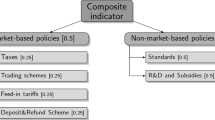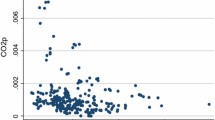Abstract
Using input–output analysis, we examine whether India can be regarded as a pollution haven. We calculate the extra CO2, SO2 and NO x emissions induced by 1 billion rupees of additional exports. This is compared with the reduction of Indian pollution caused by an import increase of equal size. In contrast to what the pollution haven hypothesis states for developing countries, we find that India considerably gains from extra trade. Comparing 1996/1997 with 1991/1992, the gains have only increased, indicating that India has moved␣further away from being a pollution haven. The outcome is robust to changes in the underlying assumptions.
Similar content being viewed by others
References
Antweiler W. (1996) The Pollution Terms of Trade. Economic Systems Research 8:361–365
Bowen H. P., Leamer E. E., Sveikauskas L. (1987) Multicountry Multifactor Tests of the Factor Abundance Theory. American Economic Review 77:791–809
Copeland B. R., Taylor M. S. (2003) Trade and the Environment: Theory and Evidence. Princeton University Press, Princeton
Daly H. (1993) Problems with Free Trade: Neoclassical and Steady-State Perspectives. In: Zaelke D., Orbuch P., Housman R. F. (eds), Trade and Environment: Law, Economics and Policy. Island Press, Washington, DC, pp. 147–157
Dean, J., M. E. Lovely and H. Wang (2004), ‚Are Foreign Investors Attracted to Weak Environmental Regulations? Evaluating Evidence from China’, World Bank USITC Working Paper 2004-01-B. Washington, DC: World Bank.
Eskeland G. S., Harrison A. E. (2003) Moving to Greener Pastures? Multinationals and the Pollution Haven Hypothesis. Journal of Development Economics 70:1–23
Fieleke, N. S. (1974), ‚The Energy Content of US Exports and Imports’, International Finance Discussion Papers, no. 51. Washington, DC: Board of Governors of the Federal Reserve System.
Harrigan J. (1997) Technology, Factor Supplies, and International Specialization: Estimating the Neoclassical Model. American Economic Review 87:475–494
Jones, T. (1998), ‚Economic Globalisation and the Environment: An Overview of the Linkages’, in OECD, Globalisation and the Environment: Perspectives from OECD and Dynamic Non Member Economies (pp. 17–28). Paris: OECD.
Keller W., Levinson A. (2002) Pollution Abatement Costs and Foreign Direct Investment Inflows to U.S. States. Review of Economics and Statistics 84:691–703
Kraines S., Yoshida Y. (2004) Process System Modeling of Production Technology Alternatives using Input–Output Tables with Sector Specific Units. Economic Systems Research 16:23–34
Leamer E. E. (1980) The Leontief Paradox, Reconsidered. Journal of Political Economy 88:495–503
Leamer E. E. (1984) Sources of International Comparative Advantage: Theory and Evidence. MIT Press, Boston
Lenzen M. (2001) A Generalized Input–Output Multiplier Calculus for Australia. Economic Systems Research 13:65–92
Leontief, W. (1953), ‚Domestic Production and Foreign Trade; The American Capital Position Re-examined’, Proceedings of the American Philosophical Society 97, 332–349.
Leontief W. (1956) Factor Proportions and the Structure of American Trade: Further Theoretical and Empirical Analysis. Review of Economics and Statistics 38:386–407
Machado G., Schaeffer R., Worrell E. (2001) Energy and Carbon Embodied in the International Trade of Brazil: An Input–Output Approach. Ecological Economics 39:409–424
Miller, R. E. and P. D. Blair (1985), Input–Output Analysis: Foundations and Extensions. Englewood Cliffs, NJ: Prentice Hall.
Millimet D., List J. A. (2004) The Case of the Missing Pollution Haven Hypothesis. Journal of Regulatory Economics 26:239–262
Mukhopadhyay K. (2002) Energy Consumption Changes and CO2 Emissions in India. Allied Publisher, New Delhi
Munksgaard J., Pedersen K. A. (2001) CO2 Accounts for Open Economies: Producer or Consumer Responsibility? Energy Policy 29:327–334
Nordström, H. and S. Vaughan (1999), ‚Trade and Environment’, Special Studies, no. 4, Geneva: WTO.
OECD (1997), Economic Globalisation and the Environment. Paris: OECD.
Pearce D. W., Warford J. J. (1993) World Without End: Economics, Environment and Sustainable Development. Oxford University Press, New York
Planning Commission (1995), A Technical Note to the Eighth Plan of India, Input–Output Transaction Table for 1991–92. New Delhi: Government of India.
Planning Commission (2000), Input–Output Transaction Table for 1996–97. New Delhi: Government of India.
Proops J. L. R., Atkinson G., B. Frhr, Schlotheim V., Simon S. (1999) International Trade and the Sustainability Footprint: A Practical Criterion for its Assessment. Ecological Economics 28:75–97
Sawhney, A. (2004), The New Face of Environmental Management in India. Aldershot, UK: Ashgate.
Smarzynska Javorcik, B. and S. J. Wei (2004), Pollution Havens and Foreign Direct Investment: Dirty Secret of Popular Myth? Contributions to Economic Analysis & Policy (The B.E Journals in Economic Analysis & Policy) 3(2), article 8.
Trefler D. (1993) International Factor Price Differences: Leontief was Right! Journal of Political Economy 101:961–987
Trefler D. (1995) The Case of Missing Trade and Other Mysteries. American Economic Review 85:1029–1046
UNFCCC (1992), United Nations Framework Convention on Climate Change. New York: UN.
Wheeler D. (2001) Racing to the Bottom? Foreign Investment and Air Pollution in Developing Countries. Journal of Environment and Development 10:225–245
Wyckoff A. W., Roop J. M. (1994) The Embodiment of Carbon in Imports of Manufactured Products: Implications for International Agreements on Greenhouse Gas Emissions. Energy Policy 22:187–194
Wright D. J. (1974) Goods and Services: An Input–Output Analysis. Energy Policy 2:307–315
Xing Y., Kolstad C. (2002) Do Lax Environmental Regulations Attract Foreign Investment? Environmental and Resource Economics 21:1–22
Acknowledgements
Earlier versions of this paper have been presented at conferences and seminars at the universities of Seville, Oviedo, Leiden and Brussels. The comments of participants and of the two anonymous referees are gratefully acknowledged.
Author information
Authors and Affiliations
Corresponding author
Appendix
Appendix
Rights and permissions
About this article
Cite this article
Dietzenbacher, E., Mukhopadhyay, K. An Empirical Examination of the Pollution Haven Hypothesis for India: Towards a Green Leontief Paradox?. Environ Resource Econ 36, 427–449 (2007). https://doi.org/10.1007/s10640-006-9036-9
Received:
Accepted:
Published:
Issue Date:
DOI: https://doi.org/10.1007/s10640-006-9036-9




